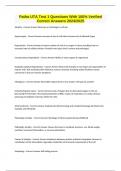Patho UTA Test 1 Questions With 100% Verified
Correct Answers 2024/2025
Atrophy - Correct Answer Decrease or shrinkage in cell size
Hypertrophy - Correct Answer Increase in size of cells that increase size of affected Organ
Hyperplasia - Correct Answer Increase number of cells in an organ or tissue resulting from an
increased rate of cellular division. Results from injury that is severe and prolonged
Compensatory Hyperplasia - Correct Answer Ability of some organs to regenerate
Dysplasia (atypical hyperplasia) - Correct Answer Abnormal changes in size shape and organization of
mature cells. Not involving entire thickness may be reversed. Involving entire thickness means
carcinoma in situ pre-invasive neoplasm
Metaplasia - Correct Answer Reversible replacement of one mature cell type by another
Ischemia/hypoxic injury - Correct Answer Lack of oxygen due to decreased oxygen in the air,
Decreased H/H function, decreased production of RBC, results of respiratory or cardiac disease,
poisoning of oxidative enzymes within the cells
Arteriosclerosis - Correct Answer Gradual arterial Narrowing and complete blockage by blood clots
example and MI/stroke
Physiologic atrophy - Correct Answer Shrinkage of thymus gland during childhood
Pathologic atrophy - Correct Answer Causes decrease in workload, pressure, use, blood supply,
nutrition, hormonal Stimulation, or nervous stimulation
Causes of atrophy - Correct Answer Imbalance between protein synthesis integration increase in
cannibalism of the intracellular organelles. Reduction of structural components of the cell.
Autophagy - Correct Answer Self eating process
,Hypoxic cellular injury - Correct Answer Ischemia which progresses to hypoxia. Lack of oxygen
delivered to the cell causes a decrease in mitochondrial function. Causing a decrease production of
ATP and increases anaerobic metabolism
Reperfusion injury - Correct Answer Makes massive amounts of free radicals, super oxide and
hydrogen peroxide free radicals cause cell damage and mitochondrial calcium overload. Reperfusion
will lead to PH alterations, osmotic changes, inflammatory signaling and mitochondrial calcium
overload. Causes opening of mitochondrial permeability transition poor which allows for the escape
of ATP and leads to apoptosis
Free radicals - Correct Answer Produced as a result of a normal cellular respiration, produced by the
absorption of extreme energy sources such as radiation are UV light, produced by metabolism of
chemicals, drugs and pesticides, produced by the transition of metals, produced by nitric oxide acting
like a chemical mediator and as a free radical
Reactive oxygen species - Correct Answer Generated during auto oxidation in the mitochondria or by
intracellular enzymatic pathways. Increased levels can lead to cellular apoptosis
Alcohol deficiencies - Correct Answer Folic acid, magnesium, vitamin B six, thiamine and phosphorus
necrosis - Correct Answer Cell death occurring in the setting of irreversible cellular injury.
Characterized by rapid loss of plasma membrane, organelle swelling, and mitochondrial dysfunction.
Leads to local cell death and auto lysis which is when the cell complete auto digestion.
Apoptosis - Correct Answer process of programmed cell death, Expected cellular process which leads
to the cells distraction. Triggered by severe cell injury, accumulation of miss folded
proteins,infections, obstruction and tissue ducts in organs with ducts
Autophagy - Correct Answer Auto digestion of the cell. A key mechanism and cellular proliferation in
development, remodeling, aging, cancer, heart disease, Neurodegenerative disease, antigen
presentation, inflammation infection, metabolic diseases.
Aging - Correct Answer Progressive loss of tissues and organs over time. Risk factors for many chronic
diseases.
, Senescence - Correct Answer Complete and permanent cessation of cellular proliferation. Cells
accumulate over time and cause organ dysfunction. Cause a loss of tissue repair abilities and
produces inflammatory molecules. Helpful for wound healing and embryogenesis
Extracellular changes with aging - Correct Answer Finding of collagen, increased free radical damage,
structural changes of the fascia, tendons, ligaments, bones and joints and the development of
arteriosclerosis. Affected by decreased synthesis and increase degration of collagen. Result in
dehydration and wrinkling of the skin
Body changes with aging - Correct Answer Thymus atrophy losses of ova and women, decreased
spermatogenesis and men, decrease responses to hormones from the breast tissue and injure
metria. Gastric emptying decreases. Muscle atrophy result from aging. Height decreases neck
thighand arm circumference decreases weight gain occurs for men and for women.
Ketogenesis - Correct Answer Formation of Keytone bodies and occurs mostly in the mitochondria of
the hepatic sites. occurs as a result of the unavailability of glucose. Deficient amounts of glucose may
occur from the depletion of carbohydrate stores or may occur because the cell is not able to use
glucose.
Action potential - Correct Answer Process by which excitable cells transmit information to one
another. Typically occurs in nerve cells and all types of muscle cells. Alteration in this may result from
neurologic disease, muscle disease or electrolyte in balance is.
Cell membrane - Correct Answer Responsible for providing structure and protection of the cell,
regulating cellular activity by receiving cellular signals, transport into and out of the cell, and cell to
cell interaction. Composed of phospholipids, cholesterol and glycolipids. Highly permeable to lipid
soluble substances such as carbon dioxide, oxygen, fatty acid's in steroid hormones. Not permeable
to water soluble substances such as ions, glucose, and amino acid's
Na/K ATPase - Correct Answer Main protein which is responsible for maintaining the correct balance
of extracellular sodium and intracellular potassium. highly involved in action potential. Essential to
maintaining the ionic balance because the cell membrane is more permeable to potassium can
diffuse easily from the intracellular space to the extracellular space.
Resting membrane potential - Correct Answer Charge between ICF and the ECF. -72 -85 mV
Depolarization - Correct Answer Movement of intracellular charge towards zero




